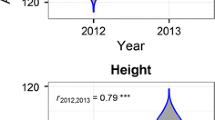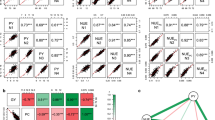Abstract
Intensively managed crop systems are normally dependent on nitrogen input to maximize yield potential. Improvements in nitrogen- use efficiency (NUE) in crop plants may support the development of cropping systems that are more economically efficient and environment friendly. The objective of this study was to map and characterize quantitative trait loci (QTL) for NUE in a maize population. In preliminary experiments, inbred lines contrasting for NUE were identified and were used to generate populations of F2:3 families for genetic study. A total of 214 F2:3 families were evaluated in replicated trials under high nitrogen (280 kg/ha) and low nitrogen (30 kg/ha) conditions in 1996 and 1997. Analysis of ear-leaf area, plant height, grain yield, ears per plant, kernels number per ear, and kernel weight indicated significant genetic variation among F2:3 families. The heritability of these traits was found to be high (h2=0.57–0.81). The mapping population were genotyped using a set of 99 restriction fragment length polymorphism (RFLP) markers. A linkage map of these markers was developed and used to identify QTL. Between two and six loci were found to be associated with each trait. The correspondence of several genomic regions with traits measured under nitrogen limited conditions suggests the presence of QTL associated with NUE. QTLs will help breeders to improve their maize ideotype of a low-nitrogen efficiency by identifying those constitutive and adaptive traits involved in the expression of traits significantly correlated with yield, such as ear leaf area and number of ears per plant.
Similar content being viewed by others
References
Agrama HAS: Sequential path analysis of grain yield and its components in maize. Plant Breeding. 115: 343–346 (1996).
Agrama HAS, Moussa ME: Mapping QTLs in breeding for drought tolerance in maize (Zea mays L.). Euphytica 91: 89–97 (1996).
Allan A, Darrah LL: 1978. Effects of three cycles of reciprocal recurrent selection on N and plant population responses of two maize hybrids in Kenya. Crop Sci 18: 112–114 (1978).
Azanza F, Tadmor Y, Klein BP, Rocheford TR, Juvik JA: Quantitative trait loci influencing chemical and sensory characteristics of eating quality in sweet corn. Genome 39: 40–50 (1996).
Beauchamp EG, Kannenberg LW, Hunter RB: Nitrogen accumulation and translocation in corn genotypes following silking. Agron J 68: 418–422 (1976).
Beavis WD, Grant D, Albertsen M, Fincher R: Quantitative trait loci for plant height in four maize populations and their associations with qualitative genetic loci. Theor Appl Genet 83: 141–145 (1991).
Beavis WD, Keim P: Identification of quantitative trait loci that are affected by environment. In: Kang MS, Gauch HG (eds) Genotype-by-Environment Interaction, pp. 123–174. CRC Press, Boca Raton, FL (1996).
Blum A: Plant Breeding for Stress Environments. CRC Press, Boca Raton, FL (1988).
Edmeades GO, Lafitte HR, Bolaños J: Selection for abiotic stress tolerance in maize. In: De-Leon CG, Granados G, Read MD (eds) Proceedings Fourth Asian Regional Maize Workshop (Islamabad, Pakistan), pp. 230–268. CIMMYT, México (1990).
Edmeades GO, Lafitte HR, Bolaños J, Chapman S, Bänziger M, Deutsch J: Developing maize that tolerates drought or low nitrogen conditions. In: Edmeades G, Deutsch J (eds) Stress Tolerance Breeding, pp. 21–84. CIMMYT, México (1994).
Eghball B, Maranville JW: Interactive effects of water and nitrogen stresses on nitrogen utilization efficiency, leaf water status and yield of corn genotypes. Commun Soil Sci Plant Anal 22: 1367–1382 (1991).
Feil B, Thiraporn R, Geisler G, Stamp P: Root traits of maize seedlings – indicators of nitrogen efficiency? In: El-Bassam N, Dambroth M, Loughman BC (eds) Genetic Aspects of Plant Mineral Nutrition, pp. 97–102. Kluwer Academic Publishers, Dordrecht, Netherlands. (1990).
Fischer KS, Edmeades GO, Johnson EC: Selection for the improvement of maize yield under moisture-deficits. Field Crops Res 22: 227–243 (1989).
Gardiner J, Coe E, Hancock MS, Hoisington D, Chao S: Development of core RFLP map in maize using an immortalized F2 population. Genetics 134: 917–930 (1993).
Gruneberg H: An analysis of the ‘pleiotropic’ effects of a new lethal mutation in rat (Mus norvegicus). Proc R Soc Lond B 125: 123–144 (1938).
Guei RG, Wassom CE: Inheritance of some drought adaptive traits in maize. I. Interrelationships between yield, flowering, and ears per plant. Maydica 37: 157–164 (1992).
Harvey PH: Hereditary variation in plant nutrition. Genetics 24: 437–461 (1939).
Helentjaris T: A genetic linkage map for maize based on RFLPs. Trends Gent 3: 217–221 (1987).
Helentjaris T, King G, Slocum M, Siedenstrang C, Wegman S: Restriction fragment polymorphisms as probes for plant diversity and their development as tools for applied plant breeding. Plant Mol Biol 5: 109–118 (1985).
Hoisington TG, Coe EH: Mapping in maize using RFLPs. In: Gustafson JP (ed) Gene Manipulation in Plant Improvement, vol. 2, pp. 331–352. Plenum Press, New York (1990).
Kamprath EJ, Moll RH, Rodriguez N: Effects of nitrogen fertilization and recurrent selection on performance of hybrid population of Zea mays L. Agron J 74: 955–958 (1982).
Kosambi DD: The estimation of map distances from recombination values. Ann Eugen 12: 172–175 (1944).
Lafitte HR, Edmeades GO: Improvement for tolerance to low soil nitrogen in tropical maize. I. Selection criteria. Field Crops Res 39: 1–14 (1994).
Lafitte HR, Edmeades GO: Improvement for tolerance to low soil nitrogen in tropical maize. II. Grain yield, biomass production, and N accumulation. Field Crops Res 39: 15–25 (1994).
Lafitte HR, Edmeades GO: Improvement for tolerance to low soil nitrogen in tropical maize. III. Variation in yield across environments. Field Crops Res 39: 27–38 (1994).
Lander ES, Botstein D: Mapping Mendelian factors underlying quantitative traits using RFLP linkage maps. Genetics 121: 185–199 (1989).
Lander ES, Green P, Abrahamson J, Barlow A, Daly MJ, Lincoln SE, Newburg L: MAPMAKER: an interactive computer package for constructing primary genetic linkage maps of experimental and natural populations. Genomics 1: 174–181 (1987).
Lebreton C, Lazic-Jancic V, Steed A, Pekic S, Quarrie SA: Identification of QTL for drought responses in maize and their use in testing causal relationships between traits. J Exp Bot 46: 853–865 (1995).
Mahon JD: Limitations to use of physiological variability in plant breeding. Can J Plant Sci 63: 11–18 (1983).
Mather K, Jinks JL: Biometrical Genetics. Cornell University Press, Ithaca, NY (1971).
Moll RH, Kamprath EJ, Jackson WA: Analysis and interpretation of factors which contribute to efficiency of nitrogen utilization. Agron J 74: 562–564 (1982).
Mollaretti G, Bosio M, Gentinetta E, Motto M: Genotypic variability for N-related traits in maize. Identification of inbred lines with high or low levels on NO3-N in the stalks. Maydica 32: 309–323 (1987).
Murali BI, Paulsen GM: Improvement of nitrogen use efficiency and its relationship to other traits in maize. Maydica 26: 63–73 (1981).
Ottaviano E, Sari-Gorla M, Pe E, Frova C: Molecular markers (RFLP and HSPs) for genetic dissection of thormotolerance in maize. Theor Appl Gent 81: 713–719 (1991).
Paterson AH, Damon S, Hewitt JD, Zamir D, Rabinowitch HD, Lincoln SE, Lander ES, Tanksley SD: Mendelian factors underlying quantitative traits in tomato: comparison across species, generations, and environments. Genetics 127: 181–197 (1991).
Pollmer WG, Eberhard D, Klein D, Dhillon BS: Genetic control of nitrogen uptake and translocation in maize. Crop Sci 19: 82–96 (1979).
Prioul J, Quarrie S, Causse M, de Vienne D: Disssecting complex physiological functions through the use of molecular quantitative genetics. J Exp Bot 48: 1151–1163 (1997).
Quarrie SA, Laurie DA, Zhu J, Lebreton C, Semikhodskii A, Steed A, Witsenboer H, Calestani C: QTL analysis to study the association between leaf size and abscisic acid accumulation in droughted rice leaves and comparisons cereals. Plant Mol Biol 35: 155–165 (1997).
Reiter RS, Coors JG, Sussman MR, Gabelman WH: Genetic analysis of tolerance to low-phosphorus stress in maize using restriction fragment length polymorphisms. Theor Appl Genet 82: 561–568 (1991).
Ribaut JM, Hoisington DH, Deutsch JA, Jiang C, Gonzalezde-Leon D: Identification of quantitative trait loci under drought conditions in tropical maize. 1. Flowering parameters and the anthesis-silking interval. Theor Appl Genet 92: 905–914 (1996).
Ribaut JM, Hoisington DA, Deutsch JA, Jiang C, Gonzalezde-Leon D: Identification of quantitative trait loci under drought conditions in tropical maize. 2. Yield components and marker-assisted selection strategies. Theor Appl Genet 94: 887–896 (1997).
Saghai-Mahoof M, Soliman K, Jorgensens R, Allard R: Ribosomal DNA spacer length polymorphisms in barley: Mendelian inheritance, chromosomal location and population dynamics. Proc Natl Acad Sci USA 81: 8014–8018 (1984).
SAS Institute: SAS language guide for person computers, Edition 6.03. SAS Institute, Cary, NC (1988).
Schepers JS, Below FE: Influence of corn hybrids on nitrogen uptake and utilization efficiency. In: Proceedings 42nd Annual Corn and Sorghum conference, pp. 172–186 (1987).
Schön CC, Lee M, Melchinger AE, Guthrie WD, Woodman WL: Mapping and characterization of quantitative trait loci affecting resistance against-second generation European corn borer in maize with aid of RFLPs. Heredity 70: 646–659 (1993).
Smith N: Response of inbred lines and crosses in maize to variation of nitrogen and phosphorus supplied as nutrients. J Agron 26: 785–804 (1934).
Springfield GH, Salter RM: Differential response of corn varieties to fertility levels and to seasons. J Agric Res 49: 991–1000 (1934).
Stuber CW, Lincoln SE, Wolff DW, Helentjaris T, Lander ES: Identification of genetic factors contributing to heterosis in a hybrid from two elite maize inbred lines using molecular markers. Genetics 132: 823–839 (1992).
Ta CT, Weiland RT: Nitrogen partitioning in maize during ear development. Crop Sci 32: 443–451 (1992).
Teyker RH, Moll RH, Jackson WA: Divergent selection among maize seedlings for nitrate uptake. Crop Sci 29: 879–884 (1989).
Torres GA, Parentoni SN, Lopes MA, Paiva E: Use of RFLPs to identify genes for aluminum tolerance in maize. In: International Symposium on Use of Induced Mutations and Molecular Techniques for Crop Improvement (Vienna, 19–23 Jun 1995), pp. 227–236 (1995).
Veldboom, LR, Lee M: Molecular marker facilitated studies of morphological traits in maize. II. Determination of QTLs for grain yield and yield components. Theor Appl Genet 89: 451–458 (1994).
Author information
Authors and Affiliations
Corresponding author
Rights and permissions
About this article
Cite this article
Agrama, H., Zakaria, A., Said, F. et al. Identification of quantitative trait loci for nitrogen use efficiency in maize. Molecular Breeding 5, 187–195 (1999). https://doi.org/10.1023/A:1009669507144
Issue Date:
DOI: https://doi.org/10.1023/A:1009669507144




